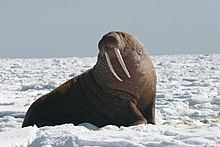
Pacific walrus

The walrus (Odobenus rosmarus) is a large flippered marine mammal with a discontinuous distribution about the North Pole in the Arctic Ocean and subarctic seas of the Northern Hemisphere. The walrus is the only living species in the family Odobenidae and genus Odobenus. This species is subdivided into two subspecies: the Atlantic walrus (O. r. rosmarus) which lives in the Atlantic Ocean and the Pacific walrus (O. r. divergens) which lives in the Pacific Ocean. Adult walrus are easily recognized by their prominent tusks, whiskers, and bulk. Adult males in the Pacific can weigh more than 2,000 kg (4,400 lb) and, among pinnipeds, are exceeded in size only by the two species of elephant seals. Walruses live mostly in shallow waters above the continental shelves, spending significant amounts of their lives on the sea ice looking for benthic bivalve mollusks to eat. Walruses are relatively long-lived, social animals, and they are considered to be a 'keystone species' in the Arctic marine regions. The walrus has played a prominent role in the cultures of many indigenous Arctic peoples, who have hunted the walrus for its meat, fat, skin, tusks, and bone. During the 19th century and the early 20th century, walruses were widely hunted and killed for their blubber, walrus ivory, and meat. The population of walruses dropped rapidly all around the Arctic region. Their population has rebounded somewhat since then, though the populations of Atlantic and Laptev walruses remain fragmented and at low levels compared with the time before human interference. The origin of the word walrus is thought by J.R.R. Tolkien to derive from a Germanic language, and it has been attributed largely to either the Dutch language or Old Norse. Its first part is thought to derive from a word such as Dutch walvis 'whale'. Its second part has also been hypothesized to come from the Old Norse word for 'horse'. For example, the Old Norse word hrossvalr means 'horse-whale' and is thought to have been passed in an inverted form to both Dutch and the dialects of northern Germany as walros and Walross. An alternative theory is that it comes from the Dutch words wal 'shore' and reus 'giant'. The species name rosmarus is Scandinavian. The Norwegian manuscript Konungsskuggsja, thought to date from around AD 1240, refers to the walrus as 'rosmhvalr' in Iceland and 'rostungr' in Greenland (walruses were by now extinct in Iceland and Norway, while the word evolved on in Greenland). Several place names in Iceland, Greenland and Norway may originate from walrus sites: Hvalfjord, Hvallatrar and Hvalsnes to name some, all being typical walrus breeding grounds. The archaic English word for walrus—morse—is widely thought to have come from the Slavic languages, which in turn borrowed it from Finno-Ugric languages. Compare морж (morž) in Russian, mursu in Finnish, morša in Northern Saami, and morse in French. Olaus Magnus, who depicted the walrus in the Carta Marina in 1539, first referred to the walrus as the ros marus, probably a Latinization of morž, and this was adopted by Linnaeus in his binomial nomenclature. The coincidental similarity between morse and the Latin word morsus ('a bite') supposedly contributed to the walrus's reputation as a 'terrible monster'. The compound Odobenus comes from odous (Greek for 'tooth') and baino (Greek for 'walk'), based on observations of walruses using their tusks to pull themselves out of the water. The term divergens in Latin means 'turning apart', referring to their tusks.
